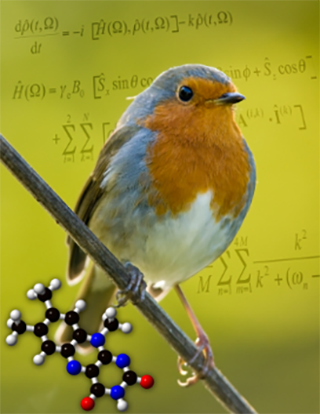Peter Hore

Professor Peter Hore FRS
Professor of Chemistry
Magnetoreception

Small night-migratory songbirds, travelling alone over thousands of kilometres, are spectacular navigators. The successful completion of these magnificent voyages depends crucially on the birds' ability to sense the direction of the Earth's magnetic field. Exactly how they do this is still a mystery, but the experimental evidence suggests something extraordinary. The birds' magnetic compass sensor seems to rely on chemical reactions in which coherent quantum phenomena indirectly allow magnetic interactions a million times smaller than thermal energies to be detected in biological tissue.
In collaboration with colleagues in the Oxford Chemistry Department (Christiane Timmel, Stuart Mackenzie, David Manolopoulos, and Justin Benesch) and at the University of Oldenburg (Henrik Mouritsen and Ilia Solov’yov), we aim to discover the biophysical mechanism of compass magnetoreception.
The primary magnetoreceptor is believed to be cryptochrome, a blue-light photoreceptor protein found in a variety of cell types in the birds’ retinas. Photo-induced electron transfer reactions within the protein produce pairs of radicals in coherent electron spin states, far removed from equilibrium. As a consequence, and because the radical recombination reactions conserve spin, exceedingly weak magnetic interactions can affect the quantum yield of a form of the protein that could act as a signalling state.
Some of the questions we are attempting to answer:
- What are the fundamental design features - magnetic, structural, kinetic, dynamic - required for a sensitive and precise chemical compass sensor?
- Which radical pair in cryptochrome is most likely to be responsible for magnetic compass sensing in vivo?
- Why are migratory birds unable to use their magnetic compass when exposed to extremely weak broadband radiofrequency noise and what does this effect tell us about the mechanism of magnetic sensing?
- How could electron spin decoherence in the wet, warm and noisy environment of a living cell be slow enough to allow birds to detect the axis of the geomagnetic field to better than ±5°?
- Is there a ‘killer experiment’ that could prove that cryptochrome really is the magnetic compass sensor?
- Could the design principles gleaned from this work be exploited to make cheap and versatile organic spintronic magnetic sensing devices?
- Is any of this relevant to concerns about the possible health effects of non-ionizing electromagnetic fields?
This work is currently funded by an ERC Synergy Grant, Quantum Birds, held jointly with Henrik Mouritsen (University of Oldenburg). I am also part of the Collaborative Research Centre, Magnetoreception and navigation in vertebrates.
A full list of publications can be found here.
Popular science articles:
I have spent most of my life in the Chemistry Department at Oxford, as an undergraduate (1973-1977), graduate (1977-1980), Junior Research Fellow (1982-83) and, since 1983, University Lecturer in Physical Chemistry. From 1983 to 2023, I was Fellow and Tutor in Chemistry at Corpus Christi College where I am now an Emeritus Fellow. My only time away from Oxford was as a postdoc at the University of Groningen (1980-82). Over the years I have worked on a number of topics around magnetic resonance and the effects of electron and nuclear spins on chemical reactivity, an area known as Spin Chemistry. These include spin hyperpolarization, protein structure and folding, photosynthetic energy conversion, and NMR methodology. Since about 2005 I have been trying to unravel the biophysical mechanism that allows migratory song birds to detect the direction of the Earth’s magnetic field as an aid to navigation.
I am the author of two Oxford Chemistry Primers on NMR.




